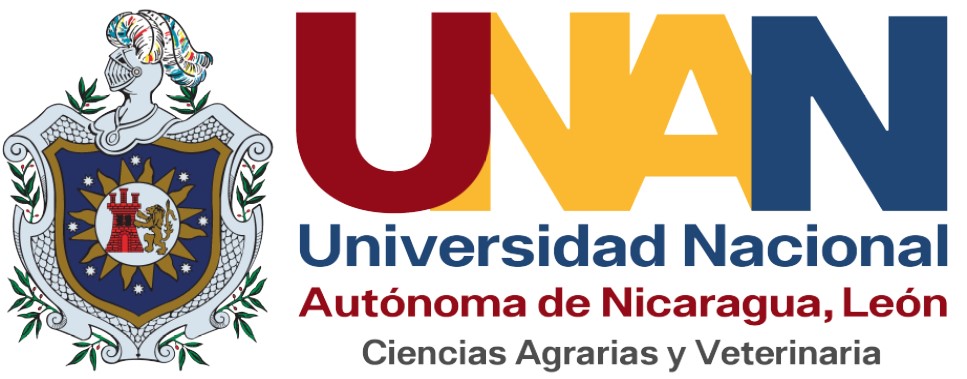Efecto de densidades de siembra en el desarrollo fenológico-productivo del Cultivo de Maíz (Zea Mays) en camas Biointensivas.
DOI:
https://doi.org/10.5377/ribcc.v8i15.14332Palabras clave:
Maíz, Biointensivo, Densidades, Cambio Climático, Seguridad alimentariaResumen
La investigación tuvo como objetivo evaluar la fenología y el rendimiento del maíz (Zea Mays) variedad criolla en tres densidades de siembra. El diseño de bloques completamente al azar, con tres tratamientos, en camas preparadas con el método biointensivo. Las densidades de siembra estudiadas fueron T1: 120 plantas/10 m2, T2: 100 plantas/10 m2 y T3: 80 plantas/10 m2. En los tres tratamientos la muestra fue de 75 plantas en total en otras palabras se eligieron 25 plantas por tratamiento al azar. En las variables fenológicas: altura el T1 sobresalió con una altura promedio de 304.44 cm; diámetro de tallo de la planta el T3 obtuvo el mayor porcentaje con 4 cm; de igual manera en número de hojas el T3 con 17 hojas promedio fue el tratamiento que presento mayor cantidad. En la cantidad de frutos se observa que el T3 presenta mejores resultados con 4 mazorcas por planta promedio; peso de la mazorca con tuza, el que obtuvo un mayor valor fue el T3 con 292.8 gr, asimismo al ser pesado sin tuza (T3: 230.74gr). Según el análisis de varianza existe diferencia significativa entre los tratamientos (p<0.05) en cuanto a las variables de producción. Por lo que se puede concluir que, para lograr una producción de plantas con tallo rígido, buena cantidad de frutos, según lo analizado anteriormente se recomienda usar el tratamiento tres (80 plantas/10m2). Recomendamos que se debe realizar investigaciones con otros cultivos de importancia para los productores y personas que estén interesados en el método biointensivo.
Descargas
Métricas
Citas
Academia Nicaragüense de la Lengua. (2001). Diccionario de uso del Español Nicaragüense. Managua, Nicaragua.
Aguilar, R. L., García, A. T., Ardisana, E. H., Téllez, O. F., Mantuano, F. V., & Quimis, W. P. (2018). Comportamiento productivo del maíz híbrido Agri-104 en diferentes sistemas, densidades de siembra y riego localizado. Revista ESPAMCIENCIA ISSN 1390-8103, 9(2), 124-130.
Amigos de la Tierra. (2003). Manual Básico para hacer compost. Madrid, España.
Arkebauer, T., Cassman, K., Dobermann, A., Drijber, R., & Lindquist, J. (2001). Investigación demuestra que rendimientos muy altos son posibles con nuevo manejo nutricional y del cultivo de maíz. Informaciones Agronómicas(Ecuador).(Oct. 2001).(, (45), 6-9.
Bolaños, J., & Edmeades, G. O. (1993). Eight cycles of selection for drought tolerance in lowland tropical maize. I. Responses in grain yield, biomass, and radiation utilization. Field Crops Research, 31(3-4), 233-252... https://doi.org/10.1016/0378-4290(93)90064-T
Caudillo, S. C., Golicher, J. D., Van del Wal, H., & Domínguez, S. V. (2006). Densidades de siembra, rendimientos y área requerida para maíz en la agricultura de roza, tumba y quema en La Chinantla, México. Agrociencia, 40(4), 449-460.
Capetillo-Burela, A., López-Collado, C. J., Zetina-Lezama, R., Reynolds-Chávez, M. A., Matilde-Hernández, C., Cadena-Zapata, M., & López-Lopez, J. A. (2021). Modelo conceptual de fertilización nitrogenada para maiz (Zea mays L.) en Veracruz, México. Revista Iberoamericana de Bioeconomía y Cambio Climático, 7(14), 1636-1656. https://doi.org/10.5377/ribcc.v7i14.12606
CIAT. (2007). Estudio sobre la sitaucion alimentaria y nutricional de, Madriz, Nueva Segovia y Region Autnoma del Atlantico Norte. Managua.
CIMMYT. (2017). Protocolos para mediciones de plantas en las plataformas de investigacion. Ciudad de Mexico.
Cordido, L. (2013). Efecto de densidad de siembra y ambiente, sobre el rendimiento de tres híbridos de maíz de siembra tardía en el oeste arenoso, Provincia de Buenos Aires. Trabajo Final de Ingeniería en Producción Agropecuaria. Facultad de Ciencias Agrarias. Universidad Católica Argentina.
CHEMONICS. (2009). PROGRAMA DE DIVERSIFICACION DE HORTALIZAS, Proyecto de Desarrollo de la cadena de valor y conglomerado Agrícola. Nicaragua: MCA/Nicaragua.
Chavarria-Torrez, A., & Castillo-Castro, S. del S. (2018). El forraje verde hidropónico (FVH), de maíz como alternativa alimenticia y nutricional para todos los animales de la granja. Revista Iberoamericana de Bioeconomía y Cambio Climatico, 4(8), 1032-1039. https://doi.org/10.5377/ribcc.v4i8.6716
FAO . (2001). El Maíz en los Trópicos Mejoramiento y Producción. Roma.
FAO. (1984). Guia tecnica sobre la tecnologia de la semilla de maiz. Roma.
Frank, S., Salisbury, F. B. & Ross, C. W. (1992). Fisiologia de las plantas. Paraninfo Thomson Learning.
García, F. (2005). Criterios para el manejo de la fertilización del cultivo de maíz. Presentado en la Jornada “Maíz.
INATEC. (2016). Manual del Protagonista Granos Basicos. Managua .
INTA. (2000). Manejo Integrado del cultivo de Maíz. Nicaragua.
INTA. (2009). Guia Tecnologica del Cultivo del Maíz. Managua, Nicaragua.
INTA. (2010). Guia Tecnologica del cultivo de Maíz. Managua, Nicaragua.
Intriago, D. I., & Torres, J. R. (2018). Efecto de la densidad y arreglo de siembra en el crecimiento, desarrollo y rendimiento del maíz (Zea mays L.). Trabajo Final de Ingeniero Agrónomo, Zamorano, Honduras.
Jarquin, J., López, I., Rostran, J., & Barcenas, M. (2015). Evaluacion del efecto de fertilizacion organica edafica con composta y bokashi en los cultivos de chiltoma (Campsicum annuum L), Tomate (Solanum Lycopersicum) y frijol (Phaseolus vulgaris), en sistema de cultivo Bio-intensivo. CNRA Campus Agropecuario, Leòn, Nicaragua: UNAN-León. Trabajo final de Ingenieria en Agroecología Tropical, UNAN, León, Nicaragua.
Jeavons, J. (1991). Cultivo biointensivo de alimentos. Ecology Actions of the Mind-Peninsula, Willits CA, EEUU.
Jeavons, J., & Cox, C. (2017). El huerto sustentable "Como obtener suelos saludables, productos sanos y abundantes". Recuperado de: https://www.ucm.es/data/cont/media/www/pag.../El%20huerto%20sustentable.pdf https://doi.org/10.1002/rwm3.20554
Liu, S., Song, F., Liu, F., Zhu, X., & Xu, H. (2012). Effect of planting density on root lodging resistance and its relationship to nodal root growth characteristics in maize (Zea mays L.). Journal of Agricultural Science, 4(12), 182. https://doi.org/10.5539/jas.v4n12p182
Laverde, H., & Cruz, R. (1979). FORMACION DE MAZORCAS EN DIFERENTES NUDOS DEL EJE DE MAIZ ICA V-510. Tibaltara.
López-González, A. S., Zúniga-González, C. A., Rangel-Cura, R. A., Dios-Palamares, R., Colón-García, A. P., & Quirós-Madrigal, O. J. (2016). Impacto de la productividad y eficiencia técnica de los granos básicos en Nicaragua, 1961 - 2013. Rev. Iberoam. Bioecon. Cambio Clim., 2(1), 411-436. https://doi.org/10.5377/ribcc.v2i1.5682
MacFall, J. M. (2015). Hacia sistemas alimentarios resilientes a través de una mayor diversidad agrícola y abastecimiento local en las Carolinas. AESS.
Medina Méndez, J., Alejo Santiago, G., Soto Rocha, J. M., & Hernández Pérez, M. (2018). Rendimiento de maíz grano con y sin fertilización en el estado de Campeche. Revista mexicana de ciencias agrícolas, 9(SPE21), 4306-4316.
Moltandin, J. (1994). Generalidades del Cultivo de Maiz. Editorial Feijóo, México.
Murányi, E. (2015). Effect of plant density and row spacing on maize (Zea mays L.) grain yield in different crop year. Columella-Journal of Agricultural and Environmental Sciences, 2(1), 57-63. https://doi.org/10.18380/SZIE.COLUM.2015.1.57.
Peña , J. L. (2011). Evaluacion de la produccion de Chilote en el cultivo de Maíz (Zea mays L) variedad HS-5G utilizando sustratos mejorados y determinación de los coeficientes "KC" y "KY", bajo Riego. Univerdad Nacional Agraria, Managua, Nicaragua.
Quemé, J. L., Zea, J. L., Perez, C., Castellanos, S., Bolaños, J., & Larios, L. (1997). Respuesta a densidad de siembra y niveles de nitrógeno de tres cultivares de maíz evaluados en tres localidades de Guatemala (No. 631.523 S618 1993-1995). CIMMYT, Guatemala (Guatemala). Programa Regional de Maíz para Centro América y el Caribe.
Reyes Castañeda, P. (1990). El Maiz y su cultivo. Mexico DF: AGT Editor.
Somarriba Rodriguez, C. (1998). Granos Basicos: texto basico.Universidad Nacional Agraria, Managua, Nicaragua.
Salmeron , F. (2000). Evaluacion de diferente niveles de nitrógenos y densidad sobre el crecimiento, desarrollo y rendimiento de Maíz (Zea mays L) . Managua, Nicaragua: Universidad Agraria .
Shafi, M. O. H. A. M. M. A. D., Bakht, J. E. H. A. N., Ali, S. A. J. J. A. D., Khan, H. A. M. A. Y. O. O. N., Khan, M. A., & Sharif, M. O. H. A. M. M. A. D. (2012). Effect of planting density on phenology, growth and yield of maize (Zea mays L.). Pak. J. Bot, 44(2), 691-696.
Songai, L. (2001). Understanding plant density effects on maize growth and development: An important issue to maximize grain yield. Cienc. Rural, 31: 159-168. https://doi.org/10.1590/S0103-84782001000100027
Valadabadi, S. A., & Farahani, H. A. (2010). Effects of planting density and pattern on physiological growth indices in maize (Zea mays L.) under nitrogenous fertilizer application. Journal of Agricultural Extension and Rural Development, 2(3), 040-047.
Villacís Seme, J. Y. (2021). Evaluación de las características morfológicas y agronómicas del cultivo de maíz (Zea Mays l.) sometido a tres densidades de siembra en la zona de ventanas, provincia de los Ríos. Bachelor's thesis, Quevedo-Ecuador.
Zamora, R. B., Barreto, A. V., Vinces, J. F., Parrales, F. S., Mendoza, J. P., & Macías, S. T. (2018). Crecimiento y producción del maíz, Zea mays L. en huertos biointensivos y convencionales en Lodana, Manabí, Ecuador. Journal of Science and Research: Revista Ciencia e Investigación, 3(4), 3-7.
Publicado
Cómo citar
Licencia
Derechos de autor 2022 Rev. iberoam. bioecon. cambio clim.

Esta obra está bajo una licencia internacional Creative Commons Atribución-NoComercial-CompartirIgual 4.0.
Copyright © 2025 Rev. iberoam. bioecon. cambio clim. Universidad Nacional Autónoma de Nicaragua León (UNAN-León), Area de Conocimiento de Ciencias Agrarias y Veterinarias/ Area Especifica de Agroecología y agronegocios /Centro de Investigación Ciencias Agrarias y Veterinarias. Dirección Académica. Departamento de Investigaçión. Unidad de publicaciones y eventos cientificos.












 EDITORIAL
EDITORIAL  e-ISSN
e-ISSN


 COPYRIGHT
COPYRIGHT  Este trabajo está licenciado bajo una Licencia Internacional
Este trabajo está licenciado bajo una Licencia Internacional 












